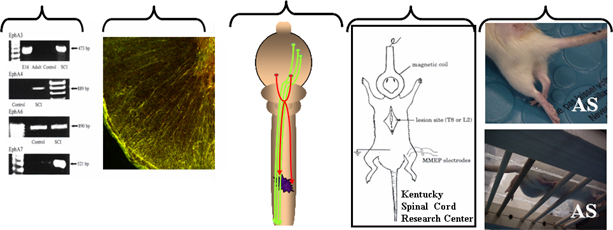Dr. Jorge D. Miranda

Contact Info
- Lab. A-682
School of Medicine
University of Puerto Rico
Medical Sciences Campus
P.O. Box 365067
San Juan, PR 00936-5067 - (787)758-2525 ext. 1631, 1615
Education
- B.S. 1988, Biology (Cellular), University of Puerto Rico, Rio Piedras, PR
- M.S. 1990, Biology (Cellular), University of Puerto Rico, Rio Piedras, PR
- Ph.D. 1996, Neuroscience, Baylor College of Medicine Houston, TX
- Postdoc 1996-1998, Spinal Cord Injury & Neuroprotection, University of Miami, School of Medicine “Miami Project to Cure Paralysis”
RESEARCH INTEREST
Laboratory of Neuroprotection
The focus of this laboratory is to determine the mechanisms of action initiated by Tamoxifen to improve locomotor recovery and increase in white matter spare tissue after SCI. We analyze the expression profile of estrogen receptors and proteins associated to the apoptotic, gliotic, oxidative, inflammatory and regenerative reaction after tamoxifen exposure and if there is any sex differences in their response. In addition, we analyze temporal and spatial protein expression of molecular signals with repellent properties that block axonal regeneration. These signals may be up-regulated after spinal cord trauma inhibiting axonal elongation and synapse formation. To study these events, adult male and female rats are moderately injured at the T10 level using the NYU/MASCIS impactor device. Defining the specific temporal and spatial expression of individual inhibitory molecules, both on the regenerating fibers and in the local microenvironment, may lead to novel therapeutic strategies to enhanced regeneration and functional recovery after SCI. Then the animals are studied at several levels:
| Molecular | Cellular | Anatomic | Physiologic | Behavioral |
|
|
||||
Scientific Collaborators
Dr. Jose Santiago, UPR-Carolina
https://www.uprc.edu/investigacion-ciencias-naturales/
Dr. Iris Salgado, UCC
https://www.uccaribe.edu/research10/researchers/researchers-virology/iris-salgado/
Dr. Walter Frontera, UPR-MSC
https://md.rcm.upr.edu/physiology/dt_team/dr-walter-frontera/
Dr. Nataliya Chorna, UPR-MSC
https://md.rcm.upr.edu/biochemistry/dt_team/dr-nataliya-chorna/
PAST AND PRESENT STUDENTS
- Lillian Cruz Orengo, PhD (2005): now Assistant Professor at UC-Davis
- Johnny D. Figueroa, PhD (2005): now Assistant Professor at Loma Linda, CA
- José M. Santiago, PhD (2011): now Associate Professor at UPR-Carolina Campus
- Luz Arocho, PhD (2011): now Clinical Supplies Senior Manager at Deciphera Pharmaceuticals, MA
- Ana Rodríguez, PhD (2011): completed her doctorate in Naturopathy and now is instructor at UCC
- Odrick Rosas, PhD (2012): completed his MD from UCC and PM& R residency at UPR-MSC
- Laurivette Mosquera, PhD (2012): completed her DMD at UPR-MSC
- Jennifer M. Colón, PhD (2018): completed her postdoctoral training at NIH and now she is working in a Biopharma
- Viviana Gonzalez
- Luis H. Pagan Rivera
Postdoctoral Fellows trained in the Laboratory
- Margarita Irizarry-Ramírez, PhD: 2000-2002
- José M. Santigao, PhD: 2012-2013
- Yaria Arroyo, PhD: 2015-2016
- Iris K. Salgado, PhD: 2013-2016
GRANTS
NIH/NIGMS
Dates: 04/01/2022-03/31/2026
Total Direct Cost: $1M
COBRE/NIEF
NIH/NIGMS
Dates: 07/01/23-06/30/28
Total Direct Cost: $5,269,445
NIH/NIGMS (T32 G-RISE)
Dates: 05/01/23-04/30/28
Total Direct Cost: $75,000
PUBLICATIONS
- Colon-Mercado JM, Torrado-Tapias AI, Salgado IK, Santiago JM, Rivera SEO, Bracho-Rincon DP, Rivera LHP, Miranda JD (2024) The sexually dimorphic expression of glutamate transporters and their implication in pain after spinal cord injury. Neural Regen Res. Doi: 10.4103/NRR.NRR-D-24-00035, PMID: 39314150
- García Sánchez LM, Colón Mercado JM, Torrado Tapias AI, Padín Díaz K, Miranda JD, and Santiago Santana JM (2023) The limited effects of estradiol administration immediately after spinal cord injury. PRHSJ (42)1, p.23-28.
- Martinez M, Martinez N, Miranda JD, Maldonado HM and Silva WI (2019) Caveolin-1 Regulates P2Y2 Receptor Signaling During Mechanical Injury in Human 1321N1 Astrocytoma. Biomolecules. Oct. 18; 9(10). PMID: 31635212
- Colón JM, González PA, Cajigas A, Maldonado WI, Torrado AI, Santiago JM, Salgado IK and Miranda JD (2018) Continuous Tamoxifen delivery improves locomotor recovery 6 hours after spinal cord injury by neuronal and glial mechanisms in male rats. Experimental Neurology. 299, p.109-121. PMID: 29037533
- Colon JM and Miranda JD (2016) Tamoxifen: an FDA approved drug with neuroprotective effects for spinal cord injury recovery. Neural Regeneration Research. 11(8): 1208-1211. PMID: 27651756
- Cruz N, Miranda JD and Crespo MJ (2016) Modulation of Vascular ACE by Oxidative Stress in Young Syrian Cardiomyopathic Hamsters: Therapeutic Implications. Journal of Clinical Medicine. 5(7). PMID: 27420103
- Martinez NA, Ayala AM, Martinez M, Martinez-Rivera FJ, Miranda JD and Silva WI (2016) Caveolin-1 Regulates the P2Y2 Receptor Signaling in Human 1321N1 Astrocytoma Cells. J. Biol Chem. 291 (23): 12208-22. PMID: 27129210.
- Colón JM, Torrado AI, Cajigas A, Santiago JM, Salgado IK, Arroyo Y and Miranda JD (2016) Tamoxifen administration immediately or 24 hours after spinal cord injury improves locomotor recovery and reduces secondary damage in female rats. J. Neurotrauma – Epub ahead of print; PMID: 26896212.
- Figueroa JD, Serrano-Illan M, Licero J, Cordero K, Miranda JD and De Leon M. (2016) Expression and roles of the lipid chaperone, FABP5, in the restorative actions mediated by docosahexaenoic acid (DHA) following experimental spinal cord injury. J. Neurotrauma – Epub ahead of print; PMID: 26715431
- Mosquera L, Arocho L, Torrado A, Torres Y, Miranda JD and Segarra AC (2015) Comparison of two methods of estradiol replacement: their physiological and behavioral outcomes. J. Vet. Sci. & Technology. 6(6): 276-284. PMID: 26962471; Manuscript ID: NIHMS749972
- Salgado IK, Torrado AI, Santiago JM, Miranda JD (2015) Tamoxifen and Src kinase inhibitors as neuroprotective/neuroregenerative drugs after spinal cord injury. Neural Regeneration Research. 10(3): 385-390. PMID: 25878585; PMC4396099
- Rosas OR, Torrado AI, Santiago JM, Rodriguez AE, Salgado IK, Miranda JD (2014) Long-term treatment with PP2 after spinal cord injury resulted in functional locomotor recovery and increased spared tissue. Neural Regeneration Research. 9 (24): 2164-2173. PMID: 25657738; PMC4316450
- Mosquera L, Colón JM, Santiago JM, Torrado AI, Melendez M, Segarra AC, Rodriguez-Orengo, JF, Miranda JD (2014) Tamoxifen and estradiol improved locomotor function and increased spared tissue in rats after spinal cord injury: their antioxidant effect and role of estrogen receptor alpha. Brain Research. 1561: 11-22. PMID: 24637260; PMC4046634
- Santos-Vera B, Vázquez-Torres R, Marrero HG, Acevedo JM, Arencibia-Albite F, Vélez-Hernández ME, Miranda JD, Jiménez-Rivera CA. (2013) Cocaine sensitization increases I h current channel subunit 2 (HCN₂) protein expression in structures of the mesocorticolimbic system. J Mol Neurosci. 50(1):234-45. PMID: 23203153
- Santiago JM, Torrado AI, Arocho LC, Rosas OR, Rodríguez AE, Toro FK, Salgado IK, Torres YA, Silva WI, Miranda JD. (2013) Expression Profile of Flotillin-2 and Its Pathophysiological Role After Spinal Cord Injury. J. Mol. Neurosci. 49(2): 347-59. PMID: 22878913
- Figueroa JD, Cordero K, Baldeosingh K, Torrado AI, Walker RL, Miranda JD, and De Leon M (2011) Docosahexaenoic Acid Pretreatment Confers Protection and Functional Improvements after Acute Spinal Cord Injury in Adult Rats. J Neurotrauma . 29(3), 551-66. PMID: 21970623
- Rodriguez-Zayas AE, Torrado AI, Rosas OR, Santiago JM, Figueroa JD and Miranda JD (2011) Blockade of P2 Nucleotide Receptors After Spinal Cord Injury Reduced the Gliotic Response and Spared Tissue. J. Mol. Neurosci. 46(1), 167-176. PMID: 21647706
- Arocho LC, Figueroa JD, Torrado AI, Santiago JM, Vera AE and Miranda JD (2011) Expression Profile and Role of EphrinA1 Ligand After Spinal Cord Injury. Cell Mol. Neurobiology. 31(7), 1057-1069. PMID: 21603973
- Odrick R, Figueroa JD, Torrado A, Rivera M, Konig-Toro F and Miranda JD (2011) Expression and activation of Ephexin Expression is altered after spinal cord injury. Developmental Neurobiology. 71(7): 595-607. PMID: 20949525
- Rodríguez-Zayas A, Torrado A, Miranda JD (2010) P2Y2 Receptor Expression is Altered in Rats after Spinal Cord Injury. International J. of Devel. Neurosci. Int. Journal of Developmental Neurosc. 28(6), 413-21. PMID: 20619335
- Santiago JM, Rosas O, Torrado AI, González MM, Kalyan-Masih PO, and Miranda JD (2009) Molecular, Anatomical, Physiological and Behavioral studies of rats treated with Buprenorphine.J. Neurotrauma. 26 (10), 1783-1793. PMID: 19653810
- Cruz-Orengo L, Figueroa JD, Torrado A, Puig A, Whittemore SR and Miranda JD (2007) Reduction of EphA4 receptor expression after spinal cord injury does not induce axonal regeneration or return of tcMMEP response. Neuroscience Letters. 418(1), 49-54. PMID: 17418490
- Willson CA, Foster RD, Onifer SM and Whittemore SR and Miranda JD (2006) EphB3 receptor and ligand expression in the adult rat CNS. J. Mol. Histol. 37(8-9), p.369-380. PMID 17103029
- Cruz-Orengo L, Velázaquez I, Torrado A, Ortiz C, Hernández C, Puig A, Segarra A, Whittemore SR and Miranda JD (2006) Blocking EphA4 upregulation after spinal cord injury results in enhanced chronic pain. Experimental Neurology. 202, p.421-433. PMID: 16959251
- Figueroa JD, Benton R, Willson CA, Velázquez I, Torrado A, Ortiz C, Whittemore SR and Miranda JD (2006) Inhibition of EphA7 Upregulation after spinal cord injury reduces Apoptosis and Promotes Locomotor Recovery. J. Neurosc. Res. 84(7), p. 1438-51. PMID: 16983667
- Irizarry-Ramírez M, Willson CA, Cruz L, Figueroa JD, Velázquez I, Jones H, Foster R, Whittemore SR and Miranda JD (2005) Upregulation of EphA3 Receptors After Spinal Cord Injry.J. of Neurotrauma 22(8), p.929-935. PMID: 16083359
- Silva WI, Maldonado HM, Velázquez G, Rubio-Dávila M, Miranda JD, Aquino E, Mayol N, Cruz-Torres A and Salgado-Villanueva IK (2005) Caveolin isoforms expression during differentiation of C6 glioma cells. Internat. J. of Develpmental Neuroscience 23, p. 599-612. PMID: 16135403
- Willson CA, Miranda JD, Foster RD, Onifer SM and Whittemore SR (2003) Transection of the adult rat spinal cord up-regulates EphB3 receptor and ligand expression. Cell Transplantation 12(3), p. 279-290. PMID: 12797382
- Willson CA, Irizarry-Ramírez M, Gaskins HE, Cruz-Orengo L, Figueroa JD, Whittemore SR and Miranda JD (2002) Upregulation of EphA Receptor Expression in the Injured Adult spinal Cord. Cell Transplantation 11(3): p.229-239. PMID: 12075988
- Miranda JD, White LA, Willson CA, Marcillo A, Jaggid J and Whittemore SR. (1999) Induction of Eph B3 after spinal cord injury. Exp.Neurol. 156, p.218. PMID: 10192794
- Miranda JD, Sin-Chieh L, Díaz ME and Barnes EM, Jr. (1997) Developmental Expression of Chick GABAA Receptor a1 subunit in vivo and in vitro. Dev. Brain Res.99, p.176-186. PMID: 9125471
- Miranda JD and Barnes EM, Jr. (1997) Repression of GABAA Receptor a1 Polypeptide Biosynthesis Requires Chronic Agonist Exposure. J. Biol. Chem. 272 (26), p.16288-16294. PMID: 9195932
- Renaud FL, Chiesa R, De Jesús JM, Lopez A, Miranda JD and Tomassini N. (1991) Hormones and Signal transduction in Protozoa. Comp. Biochem. Physiol. 100(1), p. 41-45. PMID: 1682102

